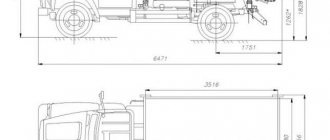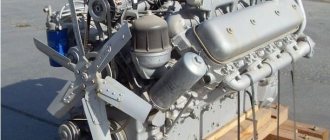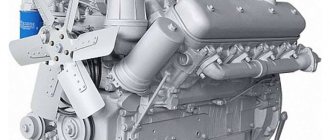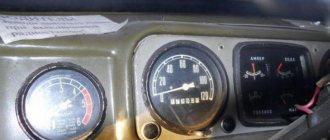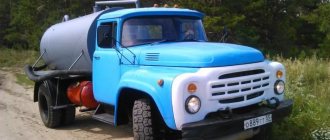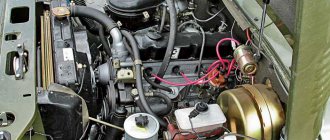Assembly procedure
This type of work takes a lot of time. First of all, a group of displacers is assembled together with the crankshaft, to which the parts are attached. Then they sort out the upper part of the frame. Change bushings, valves, seats. If the damage is severe, the parts are compacted, and cracks are repaired by welding.
After the constituent elements are brought back to normal, they proceed directly to assembly. The process is accompanied by diagnostics of the water pump; the shafts, impeller, and bearings are changed on the product. After installing the pump, attach the motor pan. The completion of assembly is accompanied by filling the circuit with oil, 10 liters are used. working fluid grade "M-8".
The final stage is running in and adjusting the valves. The engine is first “ground in” to a “cold” state, preventing combustion inside the chamber. Afterwards, the engine is started and run in “hot”, without applying loads to the unit. When the power plant travels 1000 km, the product is serviced, the lubricant and filter element are changed, and the valves are adjusted.
Motor assembly:
When working with the mechanism yourself, remember that the GAZ-52 is a forced modification of the GAZ-51, which means that the finishing and final surface treatment of the product is “cleaner” and more accurate than that of its brother. Accordingly, more time and effort is devoted to this issue. Do not neglect the instructions and technical sheets, do not disrupt the process. You can get the desired result only after going through each stage of repair; only in this case is the reliability and quality of the installation’s performance of the assigned tasks guaranteed.
Technical characteristics of the GAZ-53 dump truck and other modifications: read point by point
In the 60s of the last century, the plant, today called GAZ Group, began producing medium-duty trucks.
New power units, transmission mechanisms, cabin and body, and controls were installed on the trucks.
Models of series 52, 53, 66 formed a line of universal trucks, which, in the interests of the national economy, provided transportation in industry, for agricultural and construction needs.
How to calculate the volume of firewood in the body?
Determining the volume of firewood neatly stacked for storage is quite simple.
It is much more difficult to find out how many cubic meters are in the car that was brought to you. Let's consider, for example, how many cubic meters of firewood are in a GAZ 53. First, we need to find out the full volume of the car body. The standard Lawn has a body volume of approximately 4.8 cubic meters. If you see that the firewood is loaded without a slide, then its volume clearly cannot be higher.
There are body modifications with silo (extended) sides, whose volume is increased by 1.5 - 2 times.
In addition to the volume of the body, the laying method influences how many cubes of firewood are in the lawn. More precisely, the presence of stacking: if the firewood is neatly stacked, then it occupies almost the entire volume of the body, but if it is dumped in bulk, then there is a lot of free space between them. There is a special coefficient for converting the bulk volume into the volume of folded cubic meters.
Saransk dump truck plant
The Saransk plant has been operating since 1960, since August. By the end of the first year of its existence, the company had assembled about 10 thousand dump trucks. The plant constantly exceeded the plan and was in good standing, and by 1965 it had already produced its 100,000th dump truck. In the first years, the GAZ-SAZ 53B model rolled off the assembly line; in parallel, the SAZ 3502 model was produced with one-sided unloading of the body and its preliminary lifting. By November 1978, the company had already assembled half a million cars.
Return to contents
Differences between the 53A line and the 53
The car models have the following differences:
- reinforced front axle;
- new cardan design;
- more reliable steering gear design;
- new radiator grille;
- turn signals are duplicated by repeaters on the wings of the cabin;
- the presence of electric windshield wipers;
- cabin heating.
In 1973, model 53A was awarded the USSR State Quality Mark. Expanding the functionality of the vehicle, the production of chassis 53 01 for covered bodies and special equipment was launched.
In the gaming and souvenir industry
This section is missing references to information sources.
Information must be verifiable, otherwise it may be questioned and deleted. You may edit this article to include links to authoritative sources. This mark was set on November 5, 2013
.
- Scale models of GAZ-52 and GAZ-53 trucks on a scale of 1:43 are produced in small series by the Ukrainian workshops “Vector-models” and “Kherson-model”.
- In May 2013, a beige model from DIP Models went on sale.
Technical characteristics of GAZ-53
GAZ 53 was produced by the Gorky Automobile Plant for more than thirty years and gained enormous popularity among the population of our country. Since the beginning of production, the model has been constantly modernized, and the last basic model is the GAZ 53 12, which has been in production since 1983.
Classic GAZ 53 early modification
History of creation
The GAZ 53 model is one of the most famous and popular Soviet trucks. It belongs to the 3rd generation family of medium-duty trucks. It was produced from 1959 (serial production from 1961) until the beginning of 1993 at the Gorky Automobile Plant. With its modifications it was the most popular truck in the USSR. The total number of cars produced is more than 4 million.
In October 1961, the 3.5-ton GAZ-53F, 82 hp, began production. In July 1964, the GAZ-53 itself began to be produced - a 4-ton truck with a V-shaped 8-cylinder ZMZ-53 engine, 115 hp. In 1965, the name changed to GAZ-53A.
This model was produced in various versions for many years until 1983. The GAZ-53-02 chassis was used for dump trucks, the GAZ-53-40 was used for buses, and the GAZ-53-11 chassis was used for specialized vehicles.
Since 1983, the GAZ-53-12 model was released. The radiator has a different lining, a new cylinder head has appeared, and the chassis has also undergone changes. The carrying capacity became 4.5 tons.
In 1990, the GAZ-3307 model appeared. This is where the story of the GAZ-53 ends, but quite a lot of these vehicles are still in use today.
Interior and exterior of GAZ-53
The GAZ-53 looked very modern for its time. A one-piece radiator trim was made flush with the headlights. The frame was very durable. The gas tank is located under the driver's seat. The filler neck was located at the edge of the driver's door, behind the cab.
When switching to gas fuel, this circumstance turned out to be very convenient, since the gas cylinder could be installed under the body, whereas other trucks had a gas tank there.
The starting technology was modern at that time - an electric starter with a retractor relay, there was a good heating system and electric windshield wipers.
The driver and passenger seats were made as one unit. But, nevertheless, it was comfortable to sit in the cabin even in winter in warm clothes. There are places for tools, spare parts and other necessary things.
Car export
GAZ-53 was exported to the countries of the socialist camp: Poland, East Germany, Romania, Czechoslovakia, Yugoslavia, Hungary, Vietnam, Mongolia, as well as Finland. From 1983 to 1991, the assembly of the GAZ-53-12 was carried out by the Bulgarian enterprise Madara.
Trucks of this assembly had diesel of their own production, which was produced under license from Perkins (England).
Specifications
The truck has rear-wheel drive and a frame structure. In the factory configuration, the GAZ 53 12 is equipped with an eight-cylinder gasoline internal combustion engine with a V-shaped cylinder arrangement.
Dimensions and performance characteristics
GAZ 53 has a curb weight of 3.2 tons, and a total weight of 7.85 tons.
The car is designed for a load capacity of 4.5 tons, but in reality it is often overloaded, which is why it is necessary to repair or change the springs. A carrying capacity of 4.5 tons appeared only in the GAZ 53 12 model; the first GAZ 53F cars were generally three tons.
Dimensions
- Length – 6.4 m;
- Width – 2.4 m;
- Height (taken from the cabin, car without load) 2.2 m.
The truck is designed for a maximum permissible constant speed of up to 90 km/h, although in reality it can travel at a higher speed (110 km/h), but in an unloaded state.
Wheel characteristics
- The distance between the front and rear axles is 3.7 m;
- Wheel track on the front beam – 1.63 m;
- Rear axle wheel track – 1.69 m (measured from the point between the tires of one side to the same point on the other side);
- Ground clearance – 0.265 m;
- Wheel tire size is 8.25-20 inches.
According to factory data, the GAZ 53 should consume 24 liters per 100 km on a flat road at a speed of 40 km/h. But, apparently, what is taken into account is that the car is not loaded, the weather is dry and warm, and the car is coasting. In reality, it is almost impossible to achieve such an indicator; at a minimum, the LAZON consumes 27 liters. Depending on the loaded state, consumption can increase up to 30 liters.
General characteristics
- GAZ-53 is equipped with a 120 hp/3200 rpm engine;
- V-shaped 8-cylinder, carburetor, 4-stroke, volume 4254 cc;
- With bore/stroke 92/80 mm;
- Gearbox: 4+1 reverse;
- With a length of 6395 mm, a width of 2280 mm, a height of 2190 mm, a base of 3700 m;
- Curb weight 3200 kg;
- Load capacity 4500 kg;
- Tank capacity 90 l.
Refill tanks
- Engine oil in the engine – 10 l;
- Transmission oil in the gearbox – 3 l;
- Transmission oil in the rear axle housing – 8.2 l;
- Water or coolant in the cooling radiator – 21.5 l;
- Transmission oil in the steering – 0.8 l;
- Brake fluid in the hydraulic brake system – 0.75 l;
- Gasoline tank capacity – 90 l.
This is what the gas tank for GAZ 53 looks like
Cabin and chassis
The GAZ 53 cabin is all-metal, two-door, designed for two passengers. But the passenger seat is very wide, and if desired, three people can fit in the cabin, including the driver. The seats in the cabin are solid, not divided by the number of seats. That is, there is one common “seat” and one backrest.
The chassis structure is frame, and the cab and body are attached to it. The body may be different:
- Onboard;
- Van;
- Dump;
- Fuel tanker;
- Special purpose.
Cabin from a GAZ 53 car
Engine
The GAZ 53 car was equipped with only two types of gasoline engines. But the six-cylinder engine, which was installed on the car at the very beginning of production, was only on the GAZ 53F model, and it was produced until 1967. Afterwards, only an 8-cylinder internal combustion engine with a volume of 4.25 liters was installed on the “lawn”.
Over time, the engine index only changed and minor upgrades were carried out, but the design itself remained unchanged.
Overhead valves, an aluminum block and cylinder heads were innovative, a fresh engineering solution in the sixties of the last century. A similar engine design exists to this day - only the cylinder volume has changed and minor technical nuances have been added.
The engine on the GAZ-53-12 is ZMZ-53, overhead valve, with an aluminum block and cylinder head. The distributor and ignition coil quite often failed due to design flaws. Before major repairs, the car managed to travel 400 thousand kilometers. The engine was not particularly economical. To somehow correct this, instead of a single-chamber carburetor, a two-chamber carburetor was later used.
GAZ-53 is equipped with spring dependent suspension. The front suspension has telescopic shock absorbers. The steering wheel does not have a power steering, which is why only physically strong people could drive such a car. To change gears, you need to double-depress the clutch. The cardan transmission consists of 2 shafts, which are connected to each other using Hooke's joints.
Despite some shortcomings, the GAZ-53 was distinguished by its simplicity of design and repairability, and there were always enough spare parts for this vehicle.
An example is the ZMZ 5234 motor installed on the PAZ bus.
Characteristics of ZMZ 53
- Type – 4-stroke;
- Number of cylinders – 8;
- Compression ratio – 7.6;
- Type of gasoline used – A-76;
- Piston diameter (standard size) – 92 mm;
- Piston stroke – 80 mm;
- The diameter of the crankshaft main journals is ¬– 70 mm;
- The diameter of the crankshaft connecting rod journals is 60 mm;
- Cylinder volume – 4.25 l;
- Power, nominal value - 115 liters. With.
The engine is liquid cooled. In Soviet times, water was almost always used as a coolant, and antifreeze or antifreeze was not used on trucks.
In cold weather, I had to drain the water from the radiator after a work shift, and the next day in the morning I had to run around with buckets. On the other hand, hot water was poured in, and therefore the engine started quickly in any cold weather.
Since the engine has two rows of 4 cylinders, there are also two cylinder heads (cylinder heads). The ZMZ 53 block is cast from aluminum, and the cylinder head is made from the same metal. A massive intake manifold is located between the heads; a carburetor is installed in the center of the manifold.
The first GAZ 53 models had a K126B carburetor, then it was replaced with a K135 (later K135M).
The direction of rotation of the crankshaft of the engine is right, however, like all automobile internal combustion engines. The operating order of the cylinders is 15426378, electronic non-contact ignition, with switch-based spark amplification on the spark plugs. The first lawn models (GAZ 53F and partly GAZ 53A) had a contact system.
General information about the model
GAZ 52 is a two-axle truck with a small load capacity. In the back of this dump truck model you can transport loads weighing no more than 2.5 tons. But this drawback did not prevent the car from occupying the position of leader in the automobile industry for several decades. It was this small truck that made up the lion’s share of the truck fleet in Russia and the former Soviet republics.
To this day, GAZ 52 trucks are often found in settlements where the road surface is not of high quality or there are no roads at all. Along with their low cost, trucks are valued for their reliability, good maneuverability and the ability to easily replace parts.
Links
- GAZ-52
- GAZ-52-04 turns 30 years old
- Similarities and differences of the GAZ-52/53 families
GAZ-53/GAZ-52 on Wikimedia Commons
| Trucks, buses and all-terrain vehicles of the Gorky Automobile Plant | |
| GAZ trucks |
|
| GAZ buses |
|
| GAZ special equipment |
|
Worker from the USSR: GAZ-53
GAZ-53 (dump truck, flatbed truck, tractor...): technical characteristics and prices, photos and overview of the family (load capacity, engines...).
GAZ-53 and its modifications became the most common variants of trucks in the USSR; over more than 30 years, more than 4 million trucks under this name rolled off the assembly line.
The GAZ-53 car is a medium-duty truck of the Soviet period, produced at the Gorky Automobile Plant from 1961 to 1992. All sectors of the national economy of the Soviet Country carried out transportation on the “toiler” - GAZ-53.
The idea of solving the design of an all-metal cabin, designed for three passengers including the driver, makes the GAZ-53 similar to the ZIL-130: a long hood, protruding wings, a small interior area.
From the beginning of production until 1975, the headlights were located on top, with sidelights below them. Changes in the design of the front end with a “smile” of the radiator trim and headlights at the bottom characterize the GAZ-53 of 1975-1985.
From 1985 until the truck was discontinued in 1992, the appearance of the GAZ-53 was distinguished by a larger cladding with new side lights.
Inside, the cabin was spartanly simple and archaic: a common sofa for the driver and passengers with a backrest, behind which there was a small “cache” for things; metal in the decoration, and only on the ceiling was iron covered with panels. In those years there was no talk about the convenience and comfort of the driver.
A wide range of models for various transportations were produced on the GAZ-53 chassis with a 4x2 wheel arrangement. The main ones presented for Soviet organizations: onboard GAZ-53, GAZ 53-02 chassis for a dump truck (SAZ-3503), truck tractor, extended GAZ 53-40 chassis for the KavZ-685 bus, AL-18 (52-02)- ladder truck L2, MPR-9924 (mobile repair workshop), food truck (van), fuel truck, milk tanker.
For the needs of the Soviet Army, the GAZ-53A-016 was produced with a 105 liter fuel tank, a pre-heater, and additional equipment.
In 1984-1992, the GAZ-53-19 with an engine running on liquefied gas (methane) and the GAZ-53-27 with an engine capable of running on compressed natural gas (propane) were produced.
Export versions of GAZ-53-50 (tropical version) and GAZ-53-70 were supplied to Vietnam, Cuba, Laos, Mongolia, North Korea, Hungary, East Germany, Poland, Romania, Czechoslovakia, Finland, Yugoslavia. In 1967-1991, the production of GAZ-53 from vehicle kits was carried out at the Madara plant in the city of Shumen (Bulgaria).
If we talk about technical characteristics, then the GAZ-53 (onboard) has the following dimensions: length - 6395 mm, width - 2280 mm, height - 2190 mm, wheelbase - 3700 mm, ground clearance - 245-265 mm. The weight of the truck in running order is 3200 kg.
The GAZ-53 was equipped with 8.25 R 20 tires and a 90-liter gas tank. The front and rear suspension are dependent leaf springs, with telescopic shock absorbers in front. GAZ-53 and its modifications are equipped with drum brakes on both axles. The absence of power steering makes the process of “steering” a physically difficult task.
During production, several engines were installed on the GAZ-53; the load capacity of the “hard worker” depended on their power. Main technical characteristics of various modifications:
- GAZ-53F (1961-1967) with a forced six-cylinder GAZ-11 engine (82 hp) and a 4-speed gearbox made it possible to transport up to 3.5 tons of cargo with a maximum speed of 75 km/h, fuel consumption 22 -25 liters;
- GAZ-53 and GAZ-53A (1964-1983) were equipped with an eight-cylinder ZMZ - 53 (115 hp) with 4 gearboxes, load capacity 4000 kg. Average fuel consumption is 25 - 28 liters, maximum speed is up to 85 km/h;
- GAZ-53-12 (1983-1992) was equipped with an eight-cylinder ZMZ-511 (120 hp) with 4 gearboxes. The carrying capacity has increased to 4500 kg, the average consumption of A-76 gasoline is 25-30 liters, the maximum speed has increased to 90 km/h;
- GAZ-53-19 (1984-1992 model year) ZMZ-511 engine, when running on methane, produced 105 “horses” and provided a maximum speed of up to 80 km/h;
- GAZ-53-27 (1984-1992), when running on propane, the ZMZ-511 engine offered 100 hp. power at identical maximum speed.
Over many years of operation, the GAZ-53 has proven itself to be a technically simple, maintainable, and reliable truck. The machine can be repaired “in the field”; there are plenty of cheap spare parts on the market. With proper engine care (timely replacement of oil and filters), the service life before major overhaul is 400,000 kilometers.
The problematic components of the GAZ-53 include the clutch (short life, because it is difficult to move off without jerking), a two-part universal joint (nuts are unscrewed at the joint with Hooke joints), springs at full load cannot withstand driving on roads with poor surfaces, problems with electrical equipment (ignition distributor), the rear crankshaft oil seal is constantly leaking. The high fuel consumption is also not pleasing, since the engine is carburetor.
But the problem with fuel consumption is solved simply - they install the MMZ D-245 diesel unit. Taking into account the cost of a new engine, operating costs when switching to diesel fuel quickly pay for the investment in the car (these costs for the GAZ-53 “diesel” pay off after about 40,000 km).
Despite all the “problems” and the long-standing discontinuation of production, the GAZ-53 still “remains in service.” On the secondary market in 2022, Russian “connoisseurs” of the Soviet automobile industry can purchase it at a price of 50,000 rubles (this is the price for a GAZ-53 car in “on the move” condition). But for “well-maintained” copies of the GAZ-53 produced in 1990-1992 they ask for up to 200,000 rubles. Moreover, the most expensive on the secondary market are GAZ-53 with tanks (fuel tanker, milk tanker, sewer truck) - their price reaches 300,000 rubles.
Dimensions
| Parameter | GAZ-52-03 (long wheelbase) | GAZ-52-04 (short wheelbase) | GAZ-53A |
| Vehicle length, mm | 6395 | 5708 | 6395 |
| Vehicle width, mm | 2380 | 2200 | 2380 |
| Vehicle height, mm | 2190 | 2150 | 2220 |
| Wheelbase, mm | 3700 | 3300 | 3700 |
| Front track width, mm | 1577 | 1650 | 1630 |
| Rear track width, mm | 1650 | 1690 | 1950 |
| Overhang, mm | 866 | 866 | 866 |
| Front overhang angle | 41° | 41° | 41° |
| Rear overhang angle | 24° | 31° | 25° |
| Front ground clearance, mm | 347 | 335 | 347 |
| Rear ground clearance, mm | 265 | 245 | 265 |
| Side platform length, mm | 3740 | 3060 | 3740 |
| Side platform width, mm | 2170 | 2070 | 2170 |
| Side height, mm | 543 | 610 | 680 |
| Loading height, mm | 1280 | 1210 | 1350 |
| Total weight, kg | 5465 | 5170 | 7400 |
Dump truck GAZ-53
GAZ-53 is a Soviet medium-duty truck, produced in various modifications. Today, the car has not lost popularity among users due to its maintainability, low cost of components and impressive service life.
GAZ-53: history
Serial production of the GAZ-53 began in 1961. Over the next thirty-odd years, the car was produced in various versions, changing the indices in the name. In 1993, serial production of the GAZ-53 on the GAZ-53-12 model was completed. The cars were produced at the facilities of the Gorky plant. The equipment belongs to the third generation of GAZ.
Over the years of serial production, more than four million units of equipment were produced. Experts recognize the GAZ-53 as the most popular car in the USSR. It is interesting to note that the technical data of the machines remained virtually unchanged throughout the entire production period. The main changes concerned the design of the cabin and the instrument panel. The latest version of the exterior cladding was first released in 1984. The first GAZ-53 were similar to the classic ZIL-130.
Dump truck GAZ-53: technical characteristics
The repairable and moderately reliable GAZ-53 with a tipper mechanism continues to work in private and commercial households. The fairly durable body is equipped with an automatic lifting device. The dependent leaf spring suspension ensures a rigid ride, which is softened by telescopic shock absorbers on the front axle. The car uses a drum-type brake mechanism. There is no power steering, which makes steering difficult.
Experts attribute the short life of the clutch to the disadvantages of the machine, which affects the smooth start of movement. Fastening the cardan requires constant attention, since the nuts at the joints with the hinges are constantly unscrewed. One of the main problems is a leaking crankshaft oil seal. The electrical equipment of the machine is not reliable. A GAZ-53 with a loaded body is poorly adapted for driving on broken roads.
Engine and transmission
Over the long period of serial production of the GAZ-53, the dump truck was equipped with various engines. The first power unit was the GAZ-11 engine, a 6-cylinder 82-horsepower engine, complemented by a four-speed transmission. A car equipped with such components accelerated to 74 km/h, had a maximum load capacity of 3.5 tons and consumed from 22 to 25 liters of fuel per 100 km.
The following modifications of the GAZ-53 with index A were equipped with ZMZ-53 engines. The six-cylinder engine produced 115 hp. power and was complemented by a four-speed gearbox. The maximum speed of the vehicle reached 85 km/h, the load capacity and fuel consumption did not change. In 1983, the production of such machines was completed.
The last GAZ-53-12 was equipped with a ZMZ-511 power unit. The eight-cylinder engine produced 120 hp. power. At maximum speed, the car consumed 25-30 liters of fuel per 100 km. The lifting capacity of the equipment has increased to 4.5 tons.
“Gluttonous” power units are considered one of the main problems in operating the GAZ-53. However, Soviet mechanical engineering solved this problem. The car can be equipped with a D-245 diesel engine. The unit pays for itself, according to rough estimates, in 40 thousand kilometers.
Some GAZ-53 models were produced with gas-cylinder equipment and could run on methane. The power of such equipment was 100-105 hp, and the maximum speed reached 80 km/h.
Body dimensions of GAZ-53
- length - 6395 mm;
- width - 2280 mm;
- height 2190 mm;
- longitudinal base - 3700 mm;
- ground clearance - 265 mm;
- weight - 3200 kg.
Get an advantageous offer from direct suppliers:
Diagnostic work
After disassembly, the degree of wear and the suitability of the parts for further use are determined. Each component of the GAZ-52 engine is measured. The procedure is carried out without fail; the group of pistons and the crankshaft are carefully measured. The motor is visually inspected for deformations, chips, cracks and other mechanical damage. Afterwards, displacers are selected based on measured dimensions and weight. In this process, the main thing is to select pistons based on the repair size (82.5-83mm). If the values go beyond a larger value, there is no point in boring the core, since only installing sleeves will help in the situation.
Attention is paid to boring the crankshaft, since the part is responsible for the balance of the engine and other indicators. A special machine is used to carry out the procedure. The values of the restoration dimensions of the necks (0.25-0.75 mm), occasionally 1.0 mm. The greater the layer of metal that is removed from the neck, the greater the likelihood of engine failure.
Motor boring:
Gas 53
There are equipment, cars that become a symbol of the times. When people of the older generation remember the late Soviet era, they also remember this car, Gaz 53. It was produced at the Gorky Automobile Plant.
Vehicle information
Production of this car began in the 60s. There were several modifications of this 3rd generation technique. The car was produced until 1993. Over 30 years, more than 4 million cars were produced. A medium-tonnage truck with a capacity of 3 to 4.5 tons became the most popular truck in Soviet times. The history of Gas 53 is rich. This machine served the entire national economy of the USSR for a long time and reliably. The surviving working machines are still used in agriculture, construction sites, and public utilities.
Modifications of Gas 53 were produced in a certain order. From the start of production of the car until 1967, it was branded F. Then a truck with the letter A began to be produced - a more load-bearing vehicle and stronger. Then, in 1984, the Gas 53-19 and 53-27 models were launched. The latter has a propane-powered engine. All cars were produced in parallel, for different needs. Here is a photo of the onboard Gas 53:
This truck became the pride of the Soviet automobile industry. It was also exported abroad. Many countries bought the car. Comfortable, durable. Another modification began to take a load of up to 4.5 tons. Photo Gas 53:
Specifications
Gas 53 weighs 3 tons 250 kg. and has the following parameters:
- from the front bumper to the rear side - 6 m. 40 cm;
- from the left side to the starboard side - 2 m. 38 cm;
- height – 2 m. 22 cm;
- can carry a load of 4 tons;
- clearance from bottom to soil – 26.5 cm;
- the distance between the front and rear wheels is 3.7 meters;
- steel wheel rims;
- the distance between the front wheels is 1 meter 63 cm;
- the tank holds 90 liters of gasoline;
- dry disc clutch, driven by a lever.
The machine has drum brakes with a hydraulic booster.
Characteristics of the Gas 53 engine
Two brands of engines were installed on this car. On later ones, the movers are more powerful. Since 1966, the base vehicle has been equipped with the ZMZ 53 engine, which has the following parameters:
- gasoline, carburetor type;
- six-cylinder, four-stroke;
- engine capacity Gas 53 – 4.25 l.;
- weight – 265 kg;
- A-76 gasoline is used;
- compression ratio – 7.6;
- oil reserve – 10 liters;
- engine power Gas 53 – 115 hp;
Technical characteristics of the ZMZ 53 engine may differ slightly for different models. The difference is insignificant. The Gas 53 engine brand could only affect cargo transportation and a little on speed. The valves are located at the top. The cylinder block and cylinder head are made of aluminum alloys. Photo of the Gas 53 engine:
Cabin
The cabin is spacious. In addition to the driver, 2 more people can fit. The one-piece seat spans the entire width of the cabin and has a soft backrest. Metal frame of the cabin with two doors - left and right.
Fuel consumption
At 100 km. On the way, approximately 27 to 30 liters of gasoline are consumed, depending on the load.
Device
The frame on which the body is attached has 6 or 7 transverse beams (here an additional one was welded on, due to necessity). A front axle made of steel is fixed in front of the frame on two springs. At the ends of the front axle there are steering knuckles, where the wheels are attached using axles. The front wheels are single, with telescopic shock absorbers. The rigid frame of the truck is reinforced at the rear with a drive axle beam. There are springs on both sides. They are semi-elliptical and connected to the frame.
Between the frame and the springs there is a so-called rubber cushion. In addition, the rear suspension has additional springs. The rear wheels of this vehicle are double (two wheels on each side), for better maneuverability and stability. A well-thought-out shock absorption system allows the car to drive at a decent speed over all sorts of bumps on a dirt road without any consequences for the car.
A tug is attached to the back of the car, at the end of the frame. The spare wheel is mounted on the left. It was for its forethought in all cases that people in rural areas fell in love with this car. Cranes were even made on the basis of this machine: the body was removed, the rigid frame was strengthened with cross members, and the Gas 53 crane was bolted onto the chassis frame. In villages you can see these rarities of technology. They are still working.
Chassis
The transmission, control and running gears are connected in series. Cheap, economical parts were used. At the same time, these parts are of good quality, made of high-quality metal. The clutch is designed for changing gears, braking, and for different driving modes. The connection of the clutch assembly elements is made in such a way that when the pedal is pressed, a rod is activated, which is connected by a lever to the release fork. The four-speed gearbox transmits movement through meshing gears in second and third gears. The third and fourth gears are engaged using a synchronizer. Engaging second gear is assisted by a gear clutch. The gearbox allows you to change the speed, makes it possible to move in reverse, and allow the engine to idle. Then the engine runs and the car stops.
Gear shifting is done in two steps. The cardan transmission has two shafts with hinges at the end. Torque is transmitted to the main gear. It transmits movement through the differential to the axle shafts of the driving rear wheels. The differential is also designed to level out the ride on uneven roads and when cornering. This prevents the wheels from slipping, which means the tires wear out less. In the rear axle there is a crankcase into which oil is poured with a volume of up to 8.2 liters. Oil makes the gears work easier. The crankcase is made of cast ductile iron. To cool the engine, there is a radiator in front of the car behind the bumper. Water, 21 liters, is poured into it to cool the engine while it is running. After work, if the car is left outside in winter, the water is drained so that the water in the radiator does not freeze.
Advantages and disadvantages
The truck has many positive characteristics. Easy to drive and reliable car. Repairs can be made under any conditions. Spare parts for the car are available. The truck can run up to 400 thousand km. without major repairs. There are also disadvantages. The weak point is the brakes, clutch assembly. They fail more often than other components. Distributor, cardan, shaft - their connection points may fail. In the engine, the main bearing may have a leaking seal.
Reviews
Drivers speak well and respectfully about this car. For its reliability, endurance, unpretentiousness. They treat her kindly and speak positively about her. There are parts for it, they are cheap. You can always find them. Repair of such a car can be done in any conditions. Works well, rarely breaks.
What can be included with
The design of fastening the body to the frame can be different. The body design can be: • tipper type; • onboard; • in the form of a tank; • van; • closed body for special purposes. A crane can also be installed on this machine. The car also comes with a spare wheel.
Cost of new and used
Unfortunately, there are no new machines like this. Production of these cars was discontinued in 1993. Used cars cost between 60 and 300 thousand. Such a wide range of prices is due to many factors. First of all, the price depends on the technical condition of the car.
Analogs
Gas-3307 and Gas-3309 began to be produced in 1990. These are already 4th generation cars.
Although the car is outdated, it has not lost its significance to this day in rural areas. It is also used in cities, for household work and construction sites. This machine is available wherever transportation is needed for any needs without involving expensive vehicles. Now, when there is a shortage of equipment in the countryside, this machine helps out the villagers. As a symbol of the country's past greatness, it helps people overcome difficult times. The past Soviet era left us a good foundation. There are so many good, reliable cars of that time that are still in operation today. Among them is Gas 53.
Transmission
The clutch on the GAZ-52 is reinforced, similar to that used on the all-wheel drive GAZ-63. Compared to the GAZ-51, the casing, pressure and driven disks have been changed - increased in diameter, with friction linings and a driven disk hub, pull-out levers, pressure springs and disk mounting plates. The diameter of the driven disk, equipped with damper springs and torsional vibration dampers, was 280 mm versus 254 mm for the GAZ-51A.
The four-speed GAZ-52 gearbox is equipped with an inertia-type synchronizer in III and IV gears, designed to facilitate switching gearbox stages by equalizing the rotation speeds of the secondary shaft and the gear of the gear being engaged. Silence and durability of the gearbox were achieved through the use of helical gears of constant mesh in second and third gears.
The main driveshaft, the sliding fork with a splined end, the support for the intermediate driveshaft of both cars, as well as the intermediate driveshaft of the GAZ-52 fully corresponded to the same components of the GAZ-51A, the intermediate shaft of the extended GAZ-52A chassis (due to the increase wheelbase) - GAZ-53 shaft.


